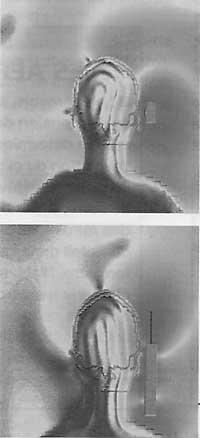Mobile phones and health
1999/06/06 Azkune Mendia, Iñaki - Elhuyar Fundazioa
Currently, 275 million people use the mobile phone and in four years 530 million will use it. During the last Christmas these devices were sold in Europe: 1.45 million in France, 1.2 million in the UK, 700,000 in Spain, 200,000 in Belgium, 125,000 in Sweden, etc. In Japan 34.5% of the population has mobile phones, in the United States 24% and in France 20%.

The impact of mobile phones on users' health is being investigated, but lately at the British University of Bristol Dr. Alan Preace concludes that the mobile phone accelerates the user's brain response speed. He has tested with 36 volunteers aged 21 to 60. Set of computer tests, memory exercises, speed analysis, etc. have been performed with a radio receiver over the left ear of the same type as the mobile phone.
After 90 minutes of testing, it has been clearly shown that volunteers respond faster when the transmitter is on. Dr. Preece solves the problem of waves accelerating electrical signals from surface areas of the brain. This is in itself a factor in altering our knowledge capabilities, but in addition, does it cause headaches, depression, memory loss, Alzheimer's or head tumors?
Keep in mind that mobile phone waves range from 800 to 1800 MHz, that is, how they are used in microwave ovens and that body tissues are heated.
Scientists have spent time studying the influence of radio frequencies on health, but in areas of high intensity and not as in mobile phones in areas of low intensity and duration. This type of research has yet begun and we will see what it is, even briefly.
Brain tumors
There is still no relationship between low-intensity radio frequency and cancer. Many research has found no relationship, but Australian scientist Michael Repacholi of Adelaide has coordinated the WHO EMF (Electromagnetic Field) project. They have received 100 GM mice, predisposed to genetically manipulated lymphomas, and have been exposed to 900 MHz radio frequencies for 18 months for one hour daily. The result has been twice as many tumors as the rest.
At the British University of Nottingham, Dr. David Pomerai had one transgenic night of nemate (worm) in a 750 MHz radio frequency zone and the next morning these larvae grew five times faster than others. Therefore, it may be thought that waves, like cancers, cause greater cell proliferation. However, Dr. Pomerai does not think this is worrying, as keeping the worm exposed to the waves for one night is equivalent to having the person for 10 years.
At the University of Washington, researcher Henry Lai has also held his sessions with rats under the waves of 2,450 MHz. Finding damaged DNA in rat head cells has led to research with frequencies on mobile phones.
Harmful to the fetus?
At the Laboratory of the University of Montpellier in France, scientist Madeleine Bastide has exposed the 60 chicken eggs three centimeters from the mobile phone. After 21 days of incubation, 60% of the embryos in the duct die and only 10% of those who had not run. However, Mrs. Madeleine Bastide says that it is also not too worrying because the pregnant woman is not with the mobile phone 24 hours a day, but that the mobile phone may have other harmful effects.
What we know for sure so far
The influence of electromagnetic wave on living beings' tissues depends on their frequency and field intensity. Digital mobile phones (GSM) operate at frequencies between 800 and 1800 MHz and are not ionizing waves, that is, they do not break the internal bonds of the molecules.
In the effects on the tissues of the waves of these frequencies, the thermal influence is the best known. The waves heat the water molecules of tissues and this heat is expelled by the thermoregulation of the organism. Energy absorption in radiofrequency zones is performed by the specific absorption rate (SAR) in watts/kg. More than 4 W/kg of radiation has harmful health effects. It produces temperature increases in body tissues above 1°C and decreases intellectual and physical capacities as body temperature increases.
According to international technical standards for the manufacture of mobile phones, the average temperature with SAR in the head of 0.1 W/kg should not exceed 1 ºC. To meet this standard, the power of the phone should not be large. The truth is that when moving from the analog to the digital system the power dropped a lot. In the analogue technology described in 1980 a power of 8 watts was used and since 1992 the digital GSM system only had a power of 2 watts. However, it is interesting to develop technologies to use even smaller powers.
Published in 7

Gai honi buruzko eduki gehiago
Elhuyarrek garatutako teknologia






